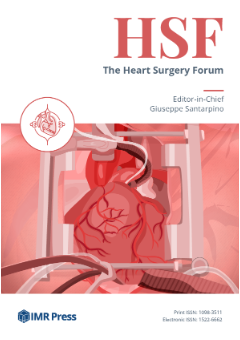Announcements
The Heart Surgery Forum (HSF) is published by IMR Press from Volume 28 Issue 9 (2025). Previous articles were published by another publisher under the CC-BY-NC licence, and they are hosted by IMR Press on imrpress.com as a courtesy and upon agreement.
Open Access
Article
Homograft Implantation for Aortic Valve Replacement Since 15 Years: Results and Follow-up
Heart Surg. Forum 2010, 13(4),
238–242;
https://doi.org/10.1532/HSF98.20091160
Published:
18 August 2010
Abstract
Background:The use of homografts in aortic valve replacement is an alternative to other prostheses and has been established in our department for 15 years.Methods:Since 1992, 360 homografts (HG) have been implanted in adult patients (mean age 51.6 years, 72.8% male). Prospective follow-up was done on an annual basis.Results:Thirty-day mortality was 5.0% (n = 17); after 5, 10, and 15 years, survival was 88.3%, 84.6%, and 76.0%, respectively. Out of 39 late deaths, 11 were valve-related (10 HG infections, 1 aortic aneurysm). Freedom from reoperation was 99.4% 1 year after operation; after 5, 10, and 15 years it was 94.1%, 78.2%, and 67.3%, respectively. Indications for HG explantation were graft infections (n = 20), calcification (n = 16), regurgitation > grade II (n = 17), perforation (n = 8), and paravalvular leakage (n = 1). Eleven transitoric ischemic attacks, 2 strokes, and 1 cerebral bleeding event were recorded. In echocardiography, the transvalvular pressure gradient changed from 10.55 to 15.02 (P= .004), 19.9 mmHg (P= .056), and 37 mmHg (not applicable) after 5, 10, and 15 years, respectively. Mean HG regurgitation was grade 0.49 before discharge and increased to 1.0 (P< .001), 0.91, and 2.5 after 5, 10, and 15 years, respectively. Ejection fraction increased from 61.9% to 64% after 5 years and to 66% after 10 years (P= .021) and then decreased to 63.5% after 15 years.Conclusions:Comparing HG with other valve prostheses, survival and graft durability seem to be confirmed. They are vulnerable to infections. The hemodynamic performance is good, and hemorrhagic or thrombo-embolic events are rare.

